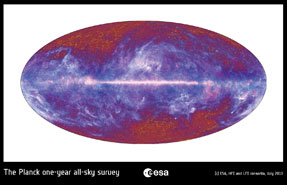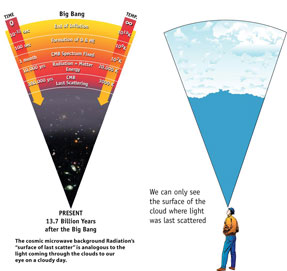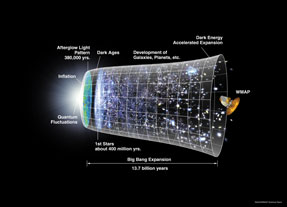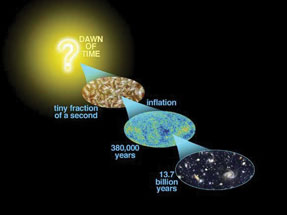Life
The Genesis Of Genesis

The Big Bang is bound to happen again and again creating new universes and recycling old ones.
| Every story has a beginning, but for cosmologists the Big Bang is the story of the beginning. The foundation of modern cosmology is based on the assumption that space and time originated from a unique event some 14 billion years ago, followed by the manifestation of everything else. According to this theory, the universe started with a bang —the Big Bang —from an unimaginably small, but infinitely dense and hot state called singularity.
The known laws of physics, such as gravity and relativity, break down in the state of singularity. But after the Big Bang, the newly born universe inflated and continues to expand. Basically from the sheer emptiness emerged our magnificent cosmos! Scientific observations support such a scenario, but no one knows what happened at the time of birth let alone before the bang. Usually cosmologists shy away from the question “what happened before the Big Bang?” dismissing it as a purely philosophical question as the Big Bang itself represents the origin of everything we know, even the absolute emptiness that we associate with nothing. Hence, it doesn’t make sense to them to talk about something before that. But, one could argue that this theory of scientific creation is not much different from the mythological or religious stories of creation except that it excludes a creator by transferring that role to the laws or forces of nature. Now, some experts question the uniqueness of this event and claim they have found evidence that the Big Bang occurred several times and the symphony of the never-ending cosmic origin is resonating everywhere. Oxford physicist Roger Penrose is one of the few physicists to confront the pre Big Bang era issues. In a recent preprint paper Penrose and another physicist V. G. Gurzadyan claim that they now have observational evidences of previous Big Bangs. Their conformal cyclic cosmology (CCC) posits the existence of an aeon preceding our own Big Bang. The cyclic nature of the universe was hypothesized much earlier by different researchers, but it is the first time that empirical evidence has been put forward. Penrose and Gurzadyan argue that the
laws of nature may evolve with time, but their theory precludes the need to introduce a theoretical beginning to the universe, as we currently presume. They use the term aeon to describe the period from our Big Bang until the remote future. Penrose explained to the BBC, “I claim that this aeon is one of a succession of such things, where the remote future of the previous aeons somehow becomes the Big Bang of our aeon.” In essence, the Big Bang is bound to happen again and again creating new universes and recycling old ones. Simply put, anything that can happen is bound to happen infinitely. The Big Bang, including its name, has always been contentious. The name itself is a misnomer as there wasn’t any bang in the first place. A bang (sound) needs to have a vibrating particle to generate it and it requires a medium for the vibrations to propagate. Since the Big Bang is the beginning of anything we can imagine, it is logical to assume that this moment of creation was in perfect silence.
This theory was one of the many for the origin of the universe, which were floating around in scientific circles in the 1930s. The other prominent theory was the Steady State Universe, promoted by Fred Hoyle, a British scientist. Georges Lemaitre, a Belgian Catholic priest, astronomer and Physics professor, applying Einstein’s theory of relativity, proposed the Big Bang as the possible origin of the universe. It essentially suggested that the presently expanding universe must have been small in the past, smaller than an atom, where all the known forces co-existed. Then came the “explosion of this cosmic egg” that created the universe, which has been expanding since its birth, 13.7 billion years ago. Although Hoyle coined the term Big Bang to ridicule the theory, the name stuck and Limiter’s theory is known as the Big Bang Theory. American Astronomer Edwin Hubble’s (Hubble Telescope is named after him) discovery that the galaxies are flying apart in an apparently expanding universe provided major support for the Big Bang theory. Eventually Hoyle’s steady state theory faded from the scientific community like the receding galaxies. But the Big Bang theory doesn’t address the question of what created the Big Bang. Cosmologists believe that complete quantum chaos must have existed at an early moment of the Big Bang, and a quantum fluctuation might have caused the bang. Such explanations lack details and are no better than mythological stories of origin.
Nonetheless, the theory is the standard framework within which most cosmologists now operate. Its position is akin to that of the theory of evolution in Biology. But some critics say this theory is propagating the Judeo-Christian concept of creation and science has sacrificed its soul to theology. The criticism stems from the fact that the theory confirms the theological notion of creation — that the universe has a definite beginning and is created with a fixed design. Nearly all the major religions, except Buddhism, have a creation myth that is tied to a creator. However, interpreting the line, “In the beginning God created the heavens and the earth,” literally to elucidate Big Bang is unwarranted and unscientific. Georges Lemaitre, who well understood the theological need for creation, probably was even inspired by the Biblical story of creation, has said that, “God cannot be reduced to the role of a scientific hypothesis.” While the monotheistic religions depend on a universe with linear progression since origin, ancient eastern philosophies like Hinduism propose a recurring nature of the universe. Accordingly, the universe has no beginning or ending, but is comprised of never ending cycles. Even the belief of birth and re-birthreflects that philosophy. In his best-selling television series Cosmos, renowned astronomer Carl Sagan reflected on the parallels between modern cosmology and Hindu philosophy, noting: “Hindu religion is the only one of the world’s great faiths dedicated to the idea that the cosmos itself undergoes an immense, indeed an infinite number of deaths and rebirths. It is the only religion in which the time scales correspond, no doubt, by accident, to those of modern scientific cosmology .… There is the deep and the appealing notion that the universe is but the dream of the god who after a 100 Brahma years dissolves himself into a dreamless sleep and the universe dissolves with him until after another Brahma century he starts recomposes himself and begins again the dream, the great cosmic lotus dream. Meanwhile, elsewhere there are an infinite number of other universes each with its own god dreaming the cosmic dream.”
As cosmologists struggle to generate a consistent model about the pre-Big Bang, the creation myths in Hindu cosmology, which describe Brahma, the creator, bringing the universe into being through his thoughts, might offer some clues. The universe survives four different yugas within a Maha Yuga. At the end of this period universe undergoes a dark age, which in turn gives way to a golden age and this cycle repeats. After the lifetime of Brahma, everything disappears into the Supreme Being and after an unimaginable period of time a new universe and new Brahma emerge. It seems that even the Gods follow the laws of nature. The metaphorical similarities between the newly proposed cyclic universe theory and Hindu cosmology are astounding. Hindus cosmology speaks about the universe being created, destroyed, and recreated in an eternally repetitive series of cycles. Brahma creates a new universe that would eventually be destroyed to begin another universe. According to Hindu cosmology, Brahma himself undergoes destruction after 100 Brahma years, 311 trillion years in the human scale, to pave the way for a new Brahma and thus a new universe. Gods are also subjected to the laws of nature and their lives occupy the cosmos in time scales that are comparable to the astronomical scales in such an oscillating universe. For instance, Kalpa, which is a day in the life of Brahma, is 4.32 billion years, the estimated age of Earth. Although there are different accounts of creation in Vedic collections, all of them clearly point to the self-repeating aspect of cosmic origins. It is comforting that, although these narratives lack scientific underpinnings and are thus not acceptable in the scientific realm, a cyclical model of the Big Bang will answer or at least negate many challenges the Big bang model now faces. The universe, it seems, has a special way of recording birth and death. The birth and death of stars are imprinted in the fabric of the cosmos. Fossils bear the indisputable evidence of the foregone era of plants and animals. How about the Universe? In fact, the evidence of the “oldest birth” is everywhere.
The discovery of Cosmic Microwave Background Radiation (CMB) in 1964 secured the position of the Big Bang as the most acceptable cosmological theory to date and turned the subject from a purely theoretical science to the most exciting scientific quest of our generation. If we could see microwaves with our eyes, the entire sky would glow with a brightness that is astonishingly uniform in every direction. This uniform radiation is the remnant heat from the Big Bang. It would be impossible for any other source to produce such uniform radiation from all the directions. NASA’s Wilkinson Microwave Anisotropy Probe (WMAP) launched in June 2001 has mapped the CMB radiation. This is the oldest light or radiation in the universe, which emerged when the universe was about 380,000 years old. Currently it remains in the microwave frequency range of the electromagnetic spectrum. Indeed, this radiation fills even our own living rooms. A small part of the noise one detects in the television or radio is from the CMB. Penrose suggests that analysis of this cosmic microwave background showed echoes of previous Big Bang-like events. The events appear as “rings” around galaxy clusters. Like the tree rings that represent the growth and age of a tree, these rings indicate the cycles of the grand cosmic tree. Accordingly, the concentric rings are caused by the clash of super massive black holes in earlier versions of our universe and imprinted ripples of smog of microwave radiation. Many questions remain unanswered and even the authors acknowledge it is not yet time to celebrate. Perhaps the Big Bang did not happen exactly as we envisage currently. The Planck satellite, currently in action, will provide more sensitive data in the coming months. That would provide in-depth analysis of the cosmic birth and force us to rewrite its history yet again.
|






